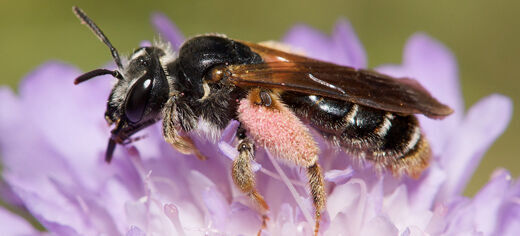
Declines in the biodiversity of pollinating insects and wild plants have slowed in recent years, according to a new study.
Researchers led by the University of Leeds and the Naturalis Biodiversity Centre in the Netherlands found evidence of dramatic reductions in the diversity of species in Britain, Belgium and the Netherlands between the 1950s and 1980s.But the picture brightened markedly after 1990, with a slowdown in local and national biodiversity losses among bees, hoverflies and wild plants.
Professor Bill Kunin, Professor of Ecology at the University of Leeds, said: “Most observers have been saying that the 1992 Rio Earth Summit targets to slow biodiversity loss by 2010 failed, but what we are seeing is a significant slowing or reversal of the declines for wild plants and their insect pollinators.
“These species are important to us. About a third of our food production, including most of our fruit and vegetables, depends on animal pollination and we know that most crop pollination is done by wild pollinators. Biodiversity is important to ensuring we don’t lose that service. Relying on a few species could be risky in a changing environment,” he added.
The study, published in the journal Ecology Letters, found a 30 per cent fall in local bumblebee biodiversity in all three countries between the 1950s and the 1980s. However, that decline slowed to an estimated 10 per cent in Britain by 2010, while in Belgium and the Netherlands bumblebee diversity had stabilised.
The picture was better for other wild bees, with an 8 per cent reduction in diversity in the Netherlands and a stable picture in Great Britain turning into significant increases (7 per cent in the Netherlands and 10 per cent in Britain) over the past 20 years.
While these solitary bees continued to decline in Belgium, hoverfly diversity improved there, shifting from stable diversity in the 1980s to significant (20 per cent) increases in recent decades. British wildflower diversity had declined about 20 per cent from the 1950s to the 1980s, but again the declines have ceased in the past 20 years.
Not all groups fared so well. Butterfly diversity continued to fall in all three countries at roughly the same rates as in the past.
Dr Luisa Carvalheiro, lead author on the paper, said: “It is possible that by 1990 the most sensitive species had already gone. However, that’s probably not the whole story, as there are still plenty of rare and vulnerable species present in recent records.
“There is a much more encouraging possibility: the conservation work and agri-environment programs paying farmers to encourage biodiversity may be having an effect. We may also be seeing a slowdown of the drivers of decline. The postwar emphasis on getting land into production and on more intensive farming has given way to a more stable situation in which the rate of landscape change has slowed and in which agrichemical excesses are regulated."
Dr Carvalheiro said: “If what we take from the Rio targets is that the investment in conservation gave us no results, then that is a counsel of despair. This study brings a positive message for conservation. But some important groups are undoubtedly still declining, so continued and increased investment in conservation practices is essential for guaranteeing the persistence of a diverse assemblage of species.”
Co-author Professor Koos Biesmeijer, who works both at the University of Leeds and Naturalis, said: “This paper builds on a widely-publicised study we published in 2006 that established that the diversity of bees and of wildflowers had declined. Our new work is based on a much bigger dataset and improved analytic methods, and it reveals much more detail about the scale and timing of biodiversity losses.
“However, while we can use biodiversity records to measure changes in the diversity of pollinators, we can’t tell what’s happening to their overall abundance or to the quality of the pollination services they provide to wildflowers or agricultural crops. To study these issues would require a long-term monitoring programme.”
The research team, including scientists from 18 institutions in Europe and the United States, used historical and contemporary records of species’ presence held by organizations including the European Invertebrate Survey, Butterfly Conservation, the Bees Wasps and Ants Recording Society, the INBO Research Institute for Nature and Forest in Belgium and the University of Mons, Belgium.
The study is published in Ecology Letters on Wednesday, May 22, 2013. This is the 21st anniversary of the signing of the Convention on Biological Diversity and has been designated by the United Nations as International Day for Biological Diversity.
The research was funded under the European Union Framework Program 7 projects Status and Trends of European Pollinators (STEP) (http://www.step-project.net/) and Securing the Conservation of biodiversity across Administrative Levels and spatial, temporal, and Ecological Scales (SCALES) (www.scales-project.net), with additional support from the UK Insect Pollinators Initiative.
Image information: The pollen specialist bee Andrena hattorfiana is rare in north-west Europe.
Photo credit: Nicolas J. Vereecken
Homepage banner image: The hoverfly Mallota fuciformis develops in rot holes in trees. It declined in the Netherlands during the 20th Century but reappeared in some localities over the past decade.
Photo credit: John T. Smit
Further information
Professor Bill Kunin and Dr Luisa Carvalheiro are available for interview.
Contact: Chris Bunting, Press Officer, University of Leeds; phone 0113 343 2049 or email c.j.bunting@leeds.ac.uk
The full paper: Luísa G. Carvalheiro, et al. ‘Species richness declines and biotic homogenization have slowed down for NW-European pollinators and plants’. Ecology Letters is published in Ecology Letters on May 22 (doi: 10.1111/ele.12121; Read the paper). It is also available on request from the University of Leeds press office.